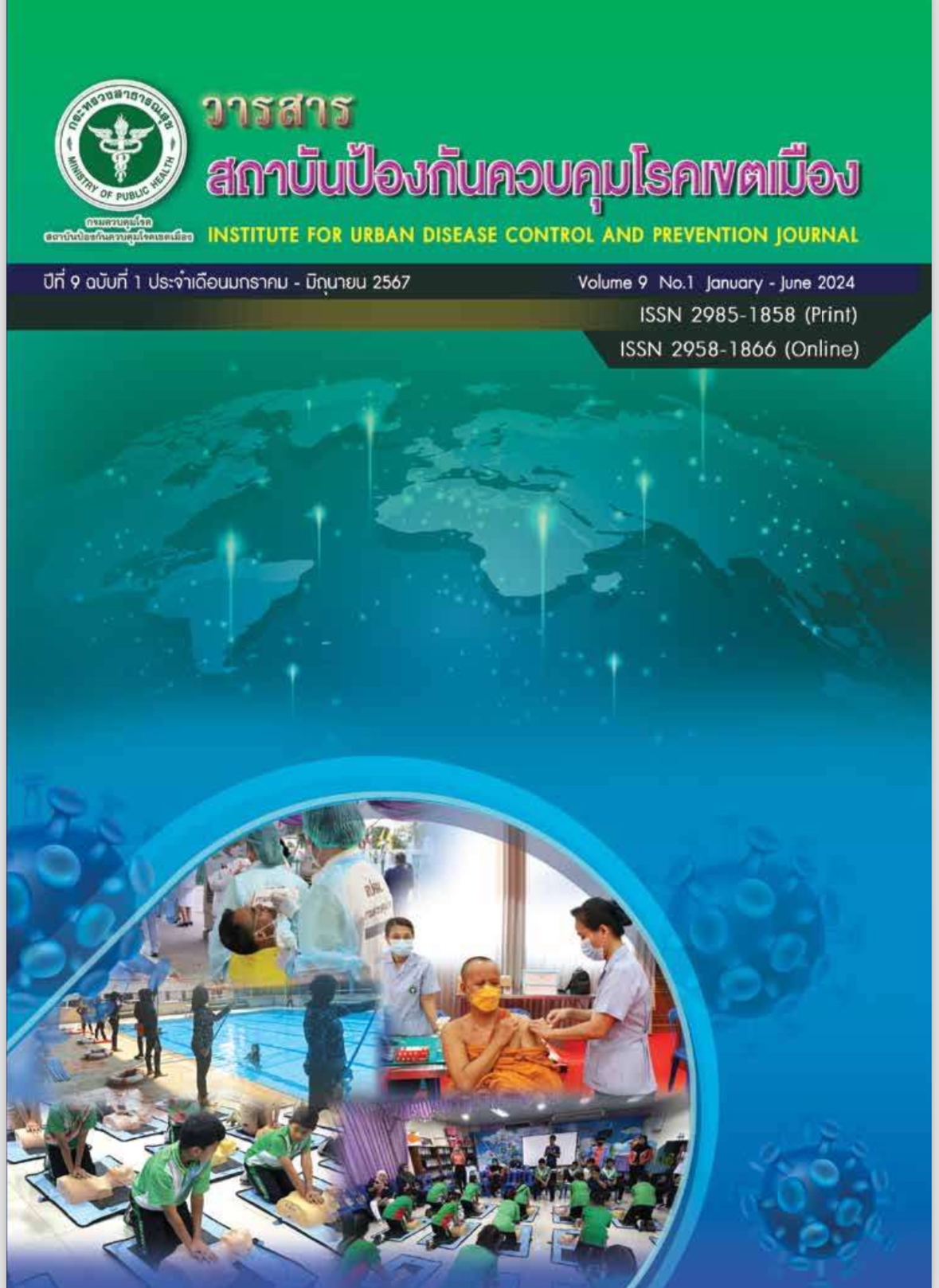ปัจจัยที่เกี่ยวข้องกับพฤติกรรมความปลอดภัยในการทำงานในแรงงานต่างด้าวสัญชาติเมียนมาที่ทำงานในกลุ่มวิสาหกิจขนาดย่อมและขนาดกลาง กรณีศึกษาโรงงานชุบชิ้นส่วนเหล็กด้วยกระแสไฟฟ้าแห่งหนึ่ง ในจังหวัดฉะเชิงเทรา ประเทศไทย
Main Article Content
บทคัดย่อ
ประเทศไทยมีแนวโน้มการนำเข้าแรงงานจากประเทศเพื่อนบ้านมากขึ้นด้วยปัญหาขาดแคลนแรงงาน และมักใช้แรงงานกลุ่มนี้ในงานที่มีความเสี่ยงหรือลักษณะงานที่แรงงานไทยส่วนใหญ่มักไม่ค่อยเลือกทำ แต่การศึกษาเกี่ยวกับพฤติกรรมความปลอดภัยในการทำงานในแรงงานต่างด้าวที่เข้ามาทำงานในประเทศไทยยังคงพบได้น้อย โดยเฉพาะในกลุ่มธุรกิจขนาดเล็ก การวิจัยครั้งนี้มีวัตถุประสงค์เพื่อศึกษาปัจจัยที่เกี่ยวข้องกับพฤติกรรมความปลอดภัยในการทำงานของแรงงานต่างด้าวในกลุ่มวิสาหกิจย่อมและขนาดกลาง โดยศึกษาแบบภาคตัดขวางในกลุ่มตัวอย่างแรงงานต่างด้าวชาวเมียนมา จำนวน 84 คน ที่เข้ามาทำงานในประเทศไทย ประเภท MOU ในโรงงานชุบชิ้นส่วนเหล็กแห่งหนึ่งจังหวัดฉะเชิงเทรา เก็บรวบรวมข้อมูลโดยใช้ล่ามสัมภาษณ์ การวิเคราะห์ข้อมูลใช้จำนวน ร้อยละ ค่าเฉลี่ย ค่ามัธยฐาน และส่วนเบี่ยงเบนมาตรฐาน สำหรับสถิติเชิงพรรณนา และสำหรับสถิติเชิงวิเคราะห์ ใช้ไคสแควร์และฟิชเช่อร์
ผลการศึกษา พบว่า ปัจจัยส่วนบุคคลของกลุ่มตัวอย่างแรงงานต่างด้าวชาวเมียนมา ได้แก่ ระยะเวลาการเข้ามาอาศัยในประเทศไทย อายุงาน ที่โรงงานนี้ การทำงานล่วงเวลา การได้รับการฝึกอบรมความปลอดภัยในการทำงานก่อนมาทำงานที่โรงงานนี้ ทักษะการฟัง และพูดภาษาไทย มีความเกี่ยวข้องกับพฤติกรรมความปลอดภัยในการทำงานแตกต่างกันอย่างมีนัยสำคัญทางสถิติ ที่ระดับ .05 (c2= 3.909 P-value = 0.048, c2= 7.591 P-value =0.006, c2= 4.598 P-value =0.032, c2= 4.508 P-value =0.034, c2= 6.364 P-value =0.012, และ c2= 4.054 P-value =0.044 ตามลำดับ) สำหรับปัจจัยอื่น ๆ ได้แก่ เพศ อายุ ระดับการศึกษาสูงสุด สถานภาพสมรส การเวียนกะ การเคยได้รับฝึกอบรมความปลอดภัยการฝึกอบรมความปลอดภัยที่โรงงานนี้ การเคยเกือบจะเกิดอุบัติเหตุหรือเกือบจะได้รับบาดเจ็บ การเคยเกิดอุบัติเหตุหรือได้รับบาดเจ็บจากการทำงาน ทักษะการอ่านและเขียนภาษาไทย ความรู้ด้านความปลอดภัยในการทำงาน ทัศนคติด้านความปลอดภัยในการทำงาน ความรอบรู้ด้านความปลอดภัยในการทำงาน และการรับรู้วัฒนธรรมความปลอดภัยและนโยบายความปลอดภัยในการทำงานขององค์กร พบว่าไม่มีความเกี่ยวข้องกับพฤติกรรมความปลอดภัยในการทำงาน
ข้อเสนอแนะจากผลการศึกษาครั้งนี้ คือ ควรศึกษาในแรงงานต่างด้าวในกลุ่ม SMEs หลากหลายประเภท และศึกษาในกิจกรรมที่จะส่งเสริมพฤติกรรมความปลอดภัยอย่างสม่ำเสมอ ส่วนการสื่อสารความปลอดภัยในการทำงานควรมีการสื่อสารทั้งในรูปแบบภาษาไทย ภาษาตามชนชาติของแรงงาน และการสื่อสารในเชิงสัญลักษณ์ เพื่อสร้างความเข้าใจและความคุ้นเคยจนเกิดเป็นวัฒนธรรมความปลอดภัยขององค์กร ตลอดจนปัจจัยด้านสุขภาพจิต ภูมิหลังของบุคคลที่อาจมีความเกี่ยวข้องกับพฤติกรรมการทำงาน
Article Details

อนุญาตภายใต้เงื่อนไข Creative Commons Attribution-NonCommercial-NoDerivatives 4.0 International License.
บทความที่พิมพ์ในวารสารสถาบันป้องกันควบคุมโรคเขตเมือง ถือว่าเป็นผลงานวิชาการ งานวิจัยและวิเคราะห์ ตลอดจนเป็นความเห็นส่วนตัวของผู้เขียนเอง ไม่ใช่ความเห็นของสถาบันป้องกันควบคุมโรคเขตเมือง หรือคณะบรรณาธิการแต่ประการใด ผู้เขียนจำต้องรับผิดชอบต่อบทความของตน
เอกสารอ้างอิง
กระทรวงแรงงาน, ศูนย์ข้อมูลแรงงานแห่งชาติ. สภาพเศรษฐกิจและแรงงานของประเทศเพื่อนบ้านที่ใกล้เคียงกับพื้นที่เขตพัฒนาเศรษฐกิจ พิเศษ. กรุงเทพฯ: กระทรวงแรงงาน; 2565.
สำนักงานส่งเสริมวิสาหกิจขนาดกลางและขยาดย่อม [อินเทอร์เน็ต]. กรุงเทพมหานคร: สำนักงาน; 2564 [เข้าถึงเมื่อ 28 ตุลาคม 2564]. เข้าถึงได้จาก: https://en.sme.go.th/th/download.php?modulekey=215&cid=0
ศิวิไล ชยางกูร. แรงงานข้ามชาติกับความต้องการดูแลผู้สูงอายุในประเทศไทย. กรุงเทพฯ: มหาวิทยาลัยราชภัฏสวนสุนันทา; 2555.
สำนักงานประกันสังคม. สถิติการประสบอันตรายหรือเจ็บป่วยเนื่องจากการทำงานของแรงงานต่างด้าว (พม่า กัมพูชา ลาว) ปี 2559 [อินเทอร์เน็ต]. กรุงเทพมหานคร: สำนักงาน; 2563 [เข้าถึงเมื่อ 25 มกราคม 2563]. เข้าถึงได้จาก: https://www.sso.go.th/wpr/assets/upload/files_storage/sso_th/af17b01a474174e851ffb132d2bd6450.pdf
Douphrate DI, Stallones L, Lunner Kolstrup C, Nonnenmann MW, Pinzke S, Hagevoort GR, et al. Work-related injuries and fatalities on dairy farm operations-a global perspective. J Agromedicine. 2013;18(3):256-64.
Başağa HB, Temel BA, Atasoy M, Yildirim I. A study on the effectiveness of occupational health and safety trainings of construction workers in Turkey. Safety Science. 2018;(110):344-54.
Flynn MA. Safety & the Diverse Workforce: Lessons From NIOSH's Work With Latino Immigrants. Prof Saf. 2014 Jun;59(6):52-57.
มหาวิทยาลัยพะเยา, กองบริหารงานวิจัยและประกันคุณภาพการศึกษา. รายงานสืบเนื่องจากการประชุมทางวิชาการระดับชาติ พะเยาวิจัย ครั้งที่ 3 23-24 มกราคม 2557 ณ อาคารเทคโนโลยีสารสนเทศเพื่อการสื่อสาร มหาวิทยาลัยพะเยา. พะเยา: มหาวิทยาลัยพะเยา; 2557.
ธนกร สิริธร. พฤติกรรมการทำงาน สภาพแวดล้อมในการทำงาน และบุคลิกภาพที่ส่งผลต่อความปลอดภัยในการทำงานของแรงงาน ต่างด้าว: กรณีศึกษาแรงงานต่างด้าวสัญชาติเมียนมาในโรงงาน ย่านมหาชัย จังหวัดสมุทรสาคร [ปริญญานิพนธ์ปริญญาบริหารธุรกิจบัณฑิต]. กรุงเทพฯ: มหาวิทยาลัยกรุงเทพ; 2559.
Burlakova II, Gubanova LV. The Definitions of Learning Process (Types of Motivation and Theories). Language and Text International Electronics Journal. 2019;6(3): 28-34.
Ulubeyli S, Kazaz A, Er B. Health and safety perception of workers in Turkey: a survey of construction sites. Int J Occup Saf Ergon. 2014;20(2):323-38.
Ronda-Perez E, Gosslin A, Martínez JM, Reid A. Injury vulnerability in Spain. Examination of risk among migrant and native
workers. Safety Science. 2019;115:36-41.
Caffaro F, Micheletti Cremasco M, Bagagiolo G, Vigoroso L, Cavallo E. Effectiveness of occupational safety and health training for migrant farmworkers: a scoping review. Public Health. 2018 Jul;160:10-17.
Demirkesen S, Arditi D. Construction safety personnel's perceptions of safety training practices. International Journal of Project
Management. 2015;33:1160-9.
Dai J, Goodrum PM. Differences in Perspectives regarding Labor Productivity between Spanish- and English-Speaking Craft Workers. Journal of Construction Engineering and Management. 2010;137(9):689-97.
Daniel WW, Cross CL. Biostatistics: Basic Concepts and Methodology for the Health Sciences. 10th ed. New Jercy: John Wiley & Sons; 2013.
Cunningham TR, Guerin RJ, Keller BM, Flynn MA, Salgado C, Hudson D. Differences in safety training among smaller and larger construction firms with non-native workers: Evidence of overlapping vulnerabilities. Saf Sci. 2018 Mar;103:62-9.
Bird FE, Germain GL, Clark MD. Loss Control Management: Practical Loss Contral Leadership. 3rd ed. Georgia: Loss Control Institute; 1985.
วรรษนันท์ นามเทพ. การรู้เท่าทันเรื่องสุขภาพ พฤติกรรมความปลอดภัยในการทำงาน วัฒนธรรมความปลอดภัยในองค์กรที่มีอิทธิพลต่อการเกิดอุบัติเหตุจากการทำงานของแรงงานข้ามชาติในโรงงานอุตสาหกรรม จังหวัดระยอง [ปริญญานิพนธ์ปริญญาพยาบาล ศาสตรมหาบัณฑิตล]. กรุงเทพฯ: มหาวิทยาลัยมหิดล; 2559.
Jenkins JRG. Marketing and customer behaviour, (The Commonwealth and international library. Essentials of marketing). Oxford: Pergamon Press; 1972.
Boschetto B, Rosa ED, Marini C, Salvatore M. Safety at Work in Italy: A Comparison of Italians and Foreigners. Espace populations sociétés. 2016; 3: 1-13.
Lee H, Chae D, Yi KH, Im S, Cho SH. Multiple risk factors for work-related injuries and illnesses in korean-chinese migrant workers. Workplace Health Saf. 2015 Jan;63(1):18-26.


